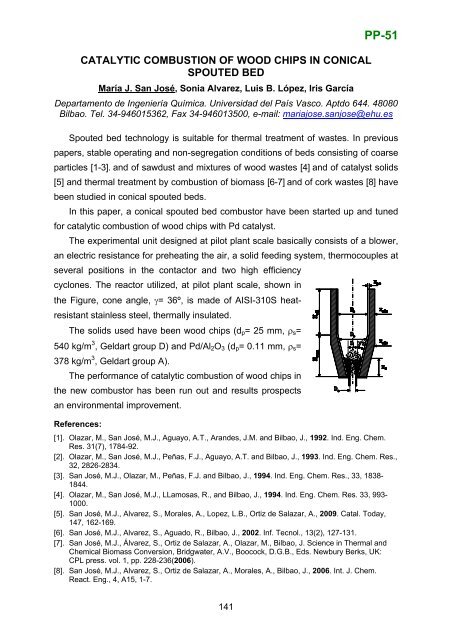Boreskov Institute of Catalysis SB RAS, Novosibirsk, Russia
Boreskov Institute of Catalysis SB RAS, Novosibirsk, Russia
Boreskov Institute of Catalysis SB RAS, Novosibirsk, Russia
- No tags were found...
You also want an ePaper? Increase the reach of your titles
YUMPU automatically turns print PDFs into web optimized ePapers that Google loves.
CATALYTIC COMBUSTION OF WOOD CHIPS IN CONICALSPOUTED BEDMaría J. San José, Sonia Alvarez, Luis B. López, Iris GarcíaPP-51Departamento de Ingeniería Química. Universidad del País Vasco. Aptdo 644. 48080Bilbao. Tel. 34-946015362, Fax 34-946013500, e-mail: mariajose.sanjose@ehu.esSpouted bed technology is suitable for thermal treatment <strong>of</strong> wastes. In previouspapers, stable operating and non-segregation conditions <strong>of</strong> beds consisting <strong>of</strong> coarseparticles [1-3]. and <strong>of</strong> sawdust and mixtures <strong>of</strong> wood wastes [4] and <strong>of</strong> catalyst solids[5] and thermal treatment by combustion <strong>of</strong> biomass [6-7] and <strong>of</strong> cork wastes [8] havebeen studied in conical spouted beds.In this paper, a conical spouted bed combustor have been started up and tunedfor catalytic combustion <strong>of</strong> wood chips with Pd catalyst.The experimental unit designed at pilot plant scale basically consists <strong>of</strong> a blower,an electric resistance for preheating the air, a solid feeding system, thermocouples atseveral positions in the contactor and two high efficiencycyclones. The reactor utilized, at pilot plant scale, shown inthe Figure, cone angle, γ= 36º, is made <strong>of</strong> AISI-310S heatresistantstainless steel, thermally insulated.The solids used have been wood chips (d p = 25 mm, ρ s =540 kg/m 3 , Geldart group D) and Pd/Al 2 O 3 (d p = 0.11 mm, ρ s =378 kg/m 3 , Geldart group A).The performance <strong>of</strong> catalytic combustion <strong>of</strong> wood chips inthe new combustor has been run out and results prospectsan environmental improvement.References:[1]. Olazar, M., San José, M.J., Aguayo, A.T., Arandes, J.M. and Bilbao, J., 1992. Ind. Eng. Chem.Res. 31(7), 1784-92.[2]. Olazar, M., San José, M.J., Peñas, F.J., Aguayo, A.T. and Bilbao, J., 1993. Ind. Eng. Chem. Res.,32, 2826-2834.[3]. San José, M.J., Olazar, M., Peñas, F.J. and Bilbao, J., 1994. Ind. Eng. Chem. Res., 33, 1838-1844.[4]. Olazar, M., San José, M.J., LLamosas, R., and Bilbao, J., 1994. Ind. Eng. Chem. Res. 33, 993-1000.[5]. San José, M.J., Alvarez, S., Morales, A., Lopez, L.B., Ortiz de Salazar, A., 2009. Catal. Today,147, 162-169.[6]. San José, M.J., Alvarez, S., Aguado, R., Bilbao, J., 2002. Inf. Tecnol., 13(2), 127-131.[7]. San José, M.J., Álvarez, S., Ortiz de Salazar, A., Olazar, M., Bilbao, J. Science in Thermal andChemical Biomass Conversion, Bridgwater, A.V., Boocock, D.G.B., Eds. Newbury Berks, UK:CPL press. vol. 1, pp. 228-236(2006).[8]. San José, M.J., Alvarez, S., Ortiz de Salazar, A., Morales, A., Bilbao, J., 2006. Int. J. Chem.React. Eng., 4, A15, 1-7.141
















